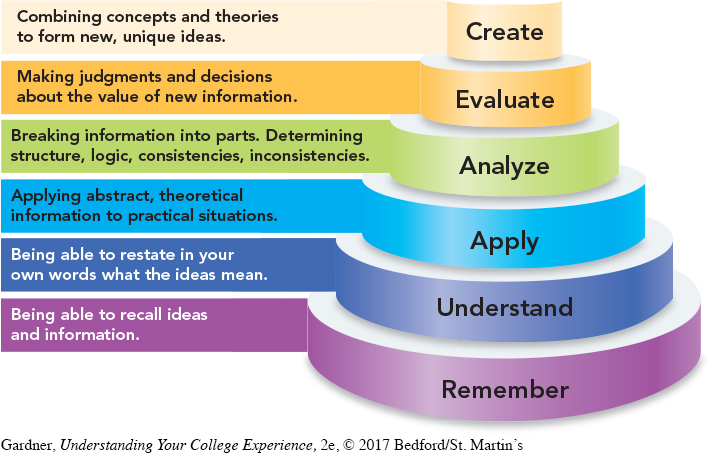10.4 BLOOM’S TAXONOMY AND THE FIRST YEAR OF COLLEGE
Benjamin Bloom, a professor of education at the University of Chicago, worked with a group of other researchers to design a system of classifying goals for the learning process. This system is known as Bloom’s Taxonomy, and it is now used at all levels of education to define and describe the process that students use to understand and think critically about what they are learning.
Bloom identified six levels of learning, as you can see in Figure 10.2. The higher the level, the more critical thinking it requires.

You have been using the levels of Bloom’s Taxonomy throughout your education, perhaps without being aware of it. As you work through the courses in your first year of college, you will recognize material you’ve learned before, and you will practice your skills of defining and remembering. You’ll become aware that the skills on Bloom’s first level aren’t going to get you very far. To retain new information, you’ll need to move to level 2, understanding the information clearly enough so that you can describe the concepts to someone else. Many of your classes will require you to apply what you learn to your experience and to new situations (level 3)—as you engage with material in this way, your comprehension grows as does your ability to retain new knowledge. Next you’ll move on to level 4 to analyze—break down information into parts—and level 5, where you evaluate new ideas, making decisions and judging them. As you reach the sixth, or highest, level, you create something new by combining information, concepts, and theories.
Let’s take a closer look at Bloom’s Taxonomy by taking a concept you’re likely to encounter in your first year of college—diversity—and matching your cognitive development of the concept to Bloom’s Taxonomy:
Level 1 (Remember): Read a dictionary definition of the word diversity.
Level 2 (Understand): Explain the concept of diversity to another student without reading the dictionary definition.
Level 3 (Apply): Write about all the types of human diversity that exist within the student body at your college and possible categories of human diversity that are not represented there.
Level 4 (Analyze): Conduct two separate analyses to break down the issue into components or questions. The first analysis will look at why your institution has large numbers of certain types of students. The second analysis will consider why your institution has small numbers of other types of students.
Level 5 (Evaluate): Write a paper that combines your findings in level 4 and hypothesizes what components of your college culture either attract or repel certain students.
Level 6 (Create): In your paper, describe your college’s “diversity profile” and suggest new ways for your campus to support diversity.
If you pay close attention, you will discover that Bloom’s Taxonomy is often the framework that college instructors use to design classroom activities and out-of-class assignments. Be aware of how you use each of these levels to build your critical-thinking skills. No matter what the topic is, this framework will help move you to deeper understanding and an ability to apply what you learn to other situations and concepts.